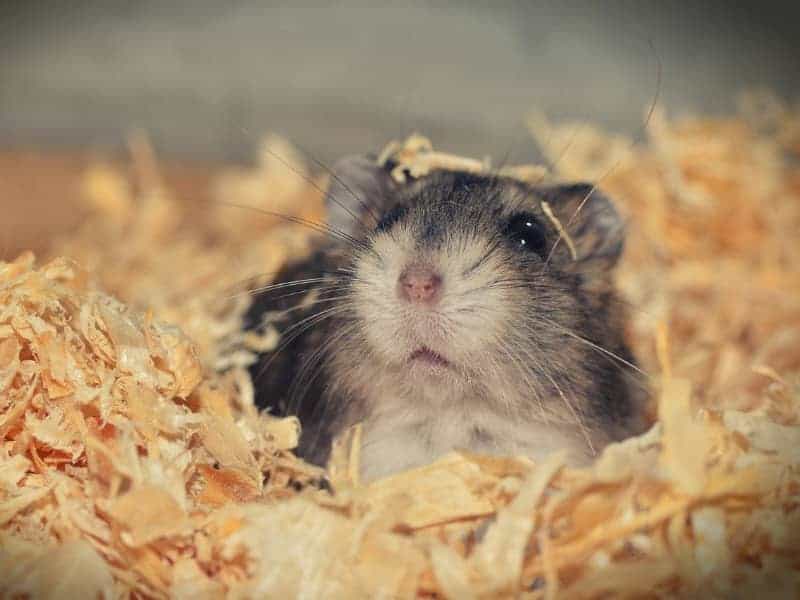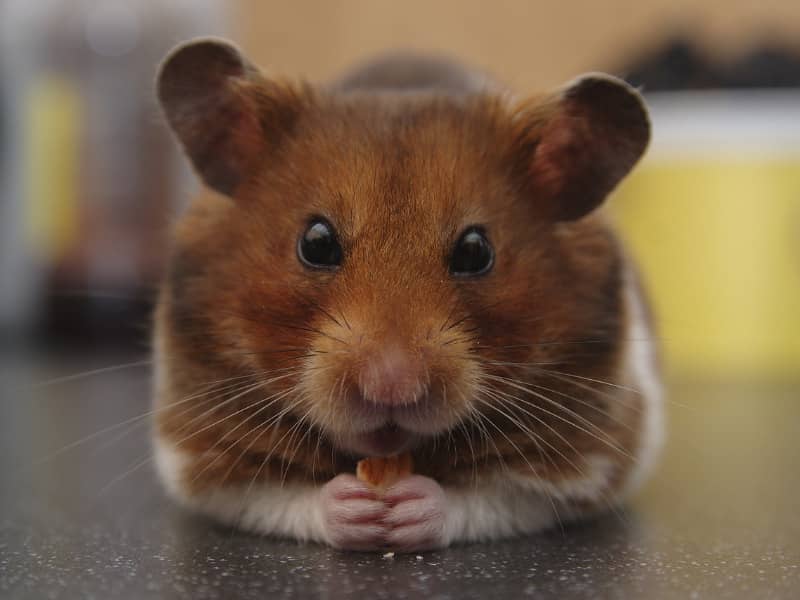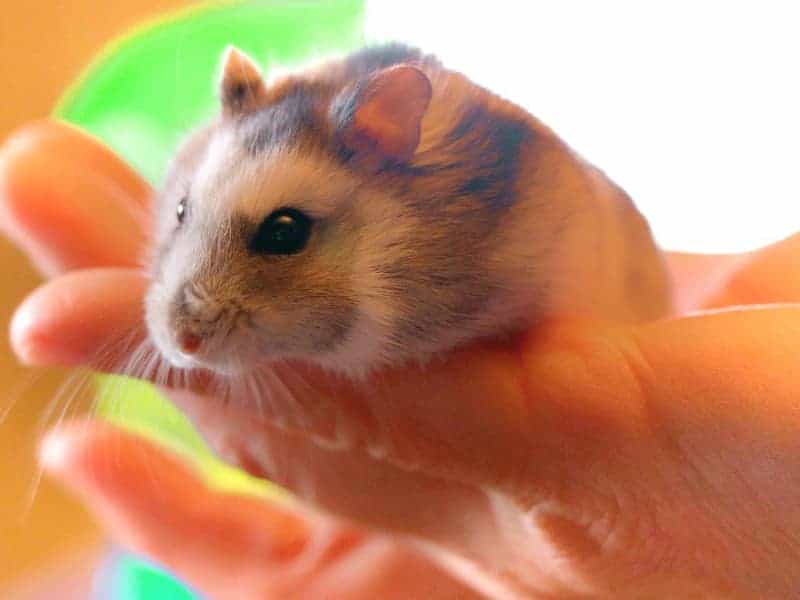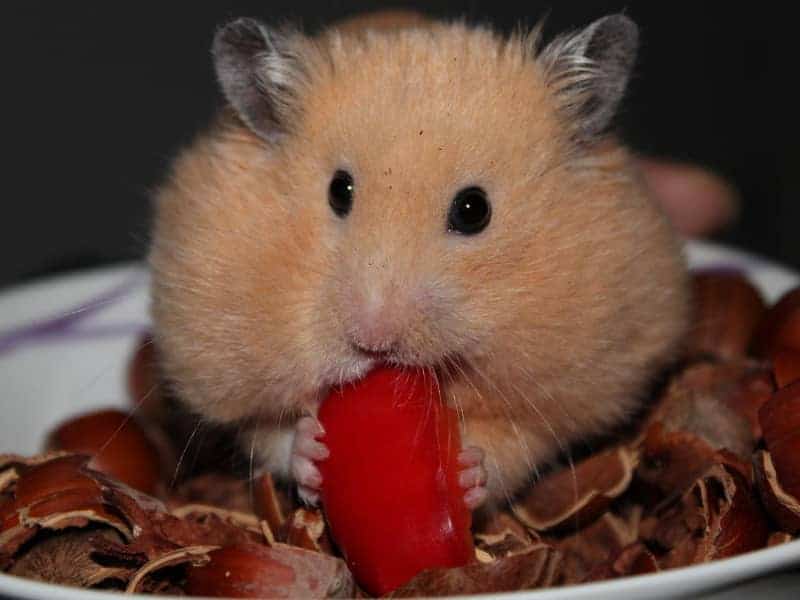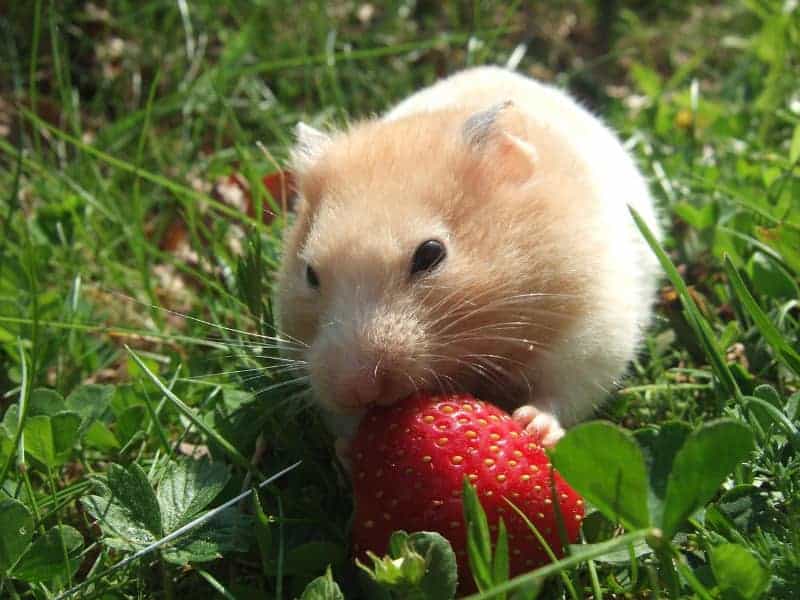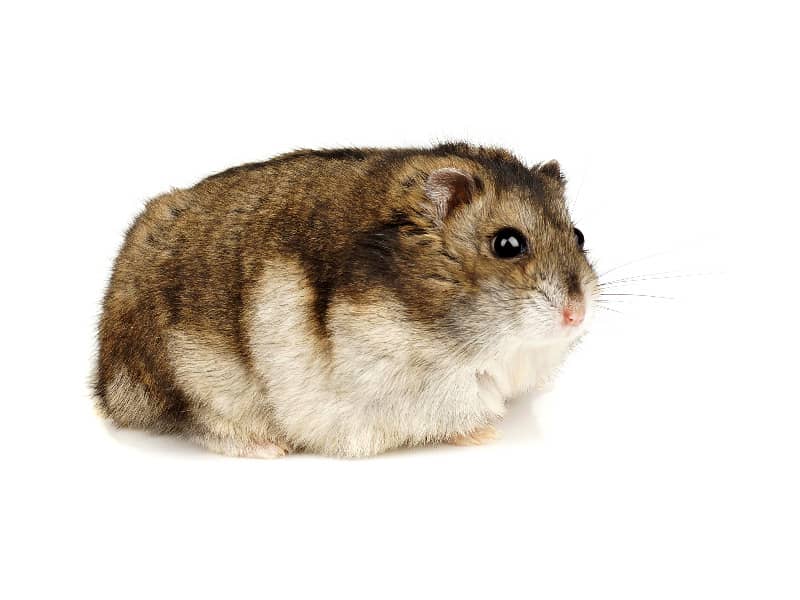
Thick hamster
Hamsters are small but active animals that love to move and play. However, as with humans, obesity can be a problem with these cute rodents. Before we can find solutions, we need to understand the causes of the "fat hamster" phenomenon.
Fat hamster - eating habits
Many hamster owners assume that hamsters can eat anything. However, this is a big mistake. Not everything that goes into the food bowl is also healthy for the little rodent. Chips, sweets or even chocolate have no place in a hamster's diet.
Hamsters are omnivores, which means that they eat both plant and animal food. However, they need a balanced diet rich in proteins, vitamins and minerals. Too much carbohydrates or fats can quickly lead to obesity.
Many commercially available hamster foods are unfortunately not ideally composed. They often contain too many sunflower seeds or nuts, which are tasty but also very high in fat. It is therefore important to choose the food carefully and, if necessary, supplement it with fresh vegetables or special hamster pellets.
Another mistake is overfeeding. Hamsters are known to collect food in their cheek pouches and hide it in their burrow. Therefore, it is difficult to estimate how much they are really eating. However, too much food can quickly lead to obesity.
Lack of exercise
A hamster that just sits in its cage all day will inevitably gain weight. Hamsters are by nature very active animals that need a lot of exercise. A running wheel is therefore a must in every hamster cage.
But be careful: not every wheel is suitable. It should be large enough so that the hamster does not hurt itself and made of a material that is easy to clean. A wheel that is too small or dirty will be avoided by the hamster, which in turn will lead to less exercise and therefore weight gain.
The lack of exercise can also be caused by an enclosure that is too small. A hamster needs enough space to run, climb and hide. If the cage is too small, the hamster cannot burn enough energy and thus gains weight.
Genetic factors
Keepers are not always to blame when a hamster becomes overweight. In some cases, genetic factors also play a role. Some hamster breeds are more prone to obesity than others.
This is especially the case with dwarf hamsters, which have a slower metabolism. If you have a hamster that is genetically prone to obesity, you should pay special attention to diet and exercise.
Health risks for fat hamsters
A fat hamster may look cute and cuddly at first glance. But being overweight is anything but cute for these little animals. It brings serious health risks that we, as responsible hamster owners, should not ignore.
Diabetes and other metabolic disorders
Fat hamsters are more prone to diabetes and other metabolic disorders. This is especially problematic because the symptoms are often difficult to recognize. Diabetes can lead to increased thirst, frequent urination, and weight loss despite overeating.
Unfortunately, diabetes in hamsters is difficult to treat and requires a strict diet and regular check-ups with the vet. In some cases, insulin injections even have to be administered. Therefore, it is better to prevent the problem by feeding the hamster a healthy diet and providing sufficient exercise.
Cardiovascular problems
As with humans, hamsters can experience cardiovascular problems if they suffer from obesity. A fat hamster has a higher risk of heart attacks and strokes. Although these problems are rare, they should not be underestimated.
Noticeable signs include rapid or irregular breathing, as well as decreased activity of the hamster. If there are signs of heart problems, a veterinarian should be consulted immediately. Unfortunately, these diseases are often difficult to treat, which makes prevention through a healthy hamster lifestyle all the more important.
Joint problems
Overweight leads to a higher load on the joints. This is not only the case in humans, but also in hamsters. An overweight hamster has an increased risk of arthritis and other joint problems.
Symptoms are often gradual and manifest as decreased mobility of the hamster. He moves less and has difficulty climbing or running in the wheel. A visit to the veterinarian is essential in such cases. Weight reduction is usually recommended to minimize the stress on the joints.
How to tell if your hamster is too fat
It is not so easy to determine whether a hamster is really overweight. These little animals naturally have a round shape that makes them look even cuddlier. But there are signs and methods to determine if your hamster has too many pounds on its ribs.
Physical signs
The easiest way to determine if a hamster is overweight is to look closely at its body. An overweight hamster often has a very round, almost spherical shape. Fatty tissue may also be clearly visible, mainly in the hip and abdominal areas.
When palpating the body, look for hard or soft areas. A healthy hamster should have good muscle mass that feels firm. Fatty tissue, on the other hand, will feel softer and less structured. If you notice any irregularities when palpating, it's time for a weight check and possibly a vet visit.
Behavioral changes
Another sign of obesity can be behavioral changes. An overweight hamster will be less active and may even have trouble running or climbing. He may start sleeping more and playing less, which can be a sign of lack of energy.
Interaction with you or other pets could also decrease. If you notice your hamster showing less interest in activities or even isolating himself, this could be a sign of a weight problem.
Weight measurement and comparison
The surest way to determine if your hamster is overweight is to measure its weight. You can use a small kitchen scale to check your hamster's weight. It is important to take the measurement regularly and document the results.
The weight of a hamster can vary depending on the breed and age. For example, a healthy golden hamster weighs between 120 and 180 grams, while a dwarf hamster often weighs only between 30 and 50 grams. A sudden increase or loss of weight should always be taken seriously and discussed with the veterinarian.
Here is a chart that lists the average hamster weight by age and sex for various hamster species:
| Hamster species | Male (Young) | Male (Adult) | Female (Young) | Female (Adult) |
| Golden hamster | 40-50 g | 120-180 g | 35-45 g | 110-160 g |
| Dwarf hamster (Campbell) | 18-22 g | 30-50 g | 15-20 g | 25-45 g |
| Dwarf hamster (Roborowski) | 16-20 g | 20-25 g | 15-19 g | 18-23 g |
| Teddy hamster | 45-55 g | 130-200 g | 40-50 g | 120-190 g |
This table can serve as a guide to help you estimate the weight of your hamster. However, please note that these values are average values and individual deviations are possible.
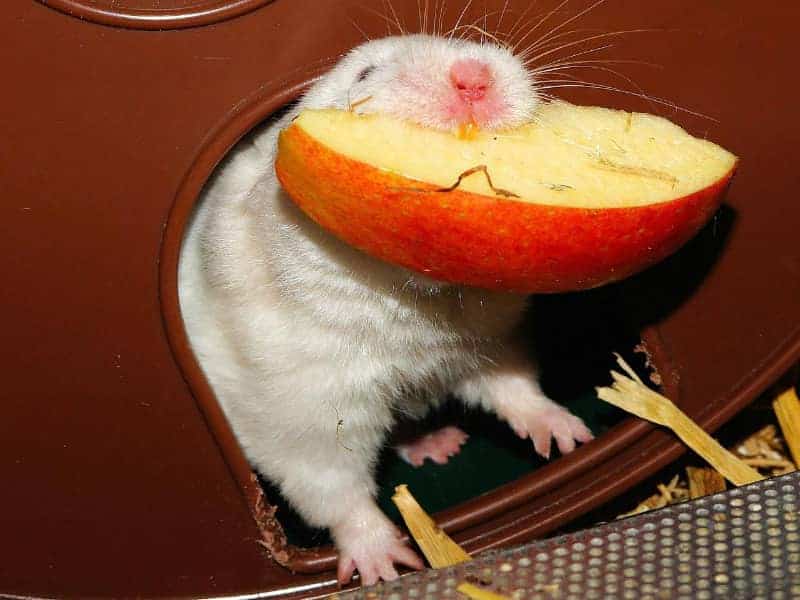
Fat hamster - weight loss tips
A fat hamster is not only cute, but often a cause for concern. It is important to take action before health problems occur. In this section we will give you some tips on how to help your hamster lose weight.
Change of diet
The first and most important step towards weight reduction is a change in diet. As already mentioned, high-fat foods such as nuts and sunflower seeds should only be fed in moderation. Instead, you should focus on protein-rich and fiber-rich foods.
Fresh vegetables are an excellent choice as long as they are given in small amounts. Carrots, broccoli and cucumbers are good options. But beware: some vegetables, such as onions and garlic, are toxic to hamsters and should be avoided.
Likewise, special hamster pellets are a good supplement, as they contain all the necessary nutrients. These pellets are available in pet stores and can be mixed with the regular food as needed.
Fat hamsters need exercise
A sedentary lifestyle is one of the main reasons for obesity in hamsters. A running wheel is therefore essential. But that alone is not enough. Try to provide your hamster with additional opportunities for movement, for example, climbing opportunities or a run outside the cage.
Toys can also be helpful to encourage the hamster to be more active. Be careful with plastic toys, however, as they can be easily destroyed and swallowed. Wooden toys are a safer choice.
Veterinary advice
If your hamster does not lose weight despite all efforts or shows health problems, it is advisable to consult a veterinarian. He or she can make an accurate diagnosis and recommend a special diet or medication if necessary.
A veterinarian may also run tests to rule out other health problems that could be causing the obesity. Sometimes a hormone imbalance or other condition is the reason for the weight gain.
Here is a table showing the comparison of nutrients in different foods for hamsters:
| Feed | Proteins (%) | Fats (%) | Carbohydrates (%) | Dietary fiber (%) | Calories (kcal/100 g) |
| Standard hamster food | 20.0 | 6.0 | 55.0 | 8.0 | 350 |
| Hamster pellets | 23.0 | 5.0 | 50.0 | 10.0 | 300 |
| Sunflower seeds | 21.0 | 51.0 | 20.0 | 8.0 | 584 |
| Carrot | 0.9 | 0.2 | 9.6 | 2.8 | 41 |
| Broccoli | 2.8 | 0.4 | 7.0 | 2.6 | 34 |
This table gives you an overview of the nutritional composition of various feeds. As you can see, sunflower seeds are very high in fat and should therefore only be fed in moderation. Hamster pellets, on the other hand, are more balanced and contain all the important nutrients.
However, it is better to replace part of the pellets or hamster food with fresh food such as vegetables, fruit, leaves, insects or even small dried worms (mealworms). This way you can slowly and specifically achieve a weight reduction in your fat hamster.
Conclusion: Thick hamsters
Fat hamsters may look cute, but obesity is a serious health problem that should not be underestimated. It can lead to a number of health problems, including diabetes, cardiovascular disease and joint problems.
The main causes of obesity in hamsters are an unbalanced diet and lack of exercise. It is therefore important to focus on a healthy diet and sufficient exercise. Fresh vegetables and special hamster pellets are often better options than high-fat seeds and nuts.
A regular check-up with a veterinarian is also advisable, especially if you notice that your hamster is showing weight gain or is less active. A veterinarian can make accurate diagnoses and give individualized advice to help your hamster reach a healthy weight and live a happy life.
Author

-
Garden animal - A life with nature
Welcome to my animal blog! My name is Dirk and I am happy to take you on my journey through the fascinating world of animals and gardening.
Born 54 years ago, I have had an insatiable curiosity for the animal world around me since childhood. Although I have moved professionally in other industries, my true passion has always been animals and nature. It is remarkable how a small garden has become such an important part of my life.
Many of my fondest memories are associated with the animals that share our home. Whether it's the curious squirrels that scurry across the trees in the morning, the colorful variety of birds that visit our feeders, or the busy bees and butterflies that pollinate our flowers, every moment with them is invaluable to me.
This blog is my contribution to share my experiences, discoveries and insights with like-minded people. Here I will share stories of unforgettable encounters with animals, give tips on gardening and creating wildlife-friendly habitats, and take you on my journeys through nature.
Thank you so much for being here!
Cordial,
Dirk aka garden animal
Last posts
- 27. February 2024PetsVeganes Hundefutter – Grün und Gesund?
- 18. January 2024ChickensOregano für Hühner
- November 27, 2023HamsterDiurnal hamsters
- November 24, 2023HamsterHamster hammock

